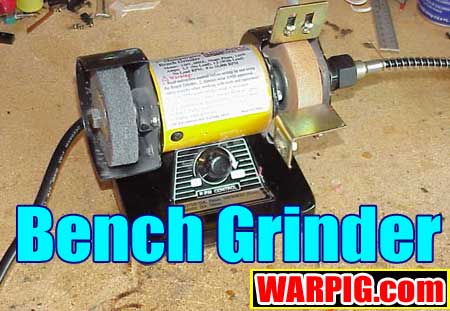  |
|
|
|
|
|
|
  |
|
|
|
|
|
|

What
do you think?
|

3" Bench Grinder From Airsmith.com by Bill Mills For an airsmith, getting the job done right means having the right tools on hand. A bench grinder is a very useful tool for metalworking. Its primary purpose is grinding or polishing metals. Another handy tool many airsmiths have on hand is a Dremel brand Moto Tool, or similar small high speed rotary tool with bits for detailed cutting, polishing or grinding.
This first feature that I really noticed was the size. For a grinder, this thing is small. I’m used to the full size grinder in my wife’s Grandfather’s shop where I learned about metal working. Owing to its small size, the 3” grinder doesn’t need much space on the workbench and is light enough to easily move around for storage.
Like most bench grinders, this one features two wheels. One for grinding, and a fiber wheel that is loaded with a mild abrasive. I found the fiber wheel to work well for first rough polishing on aluminum, using it to clean up some tooling dings that were on a feed-neck. It is too coarse to provide a mirrored finish, but did a great job at buffing out the scratches and left the metal with a frosted look ready for a final polish with a cotton wheel and polishing compound. Both wheels on the grinder are removeable, so raking one off to swap for a cloth polishing wheel is no problem, though the light horsepower of the motor wouldn’t be ideal for that task. The bonus of this grinder lies in the flex wand, making it two tools for the price of one. The unit sells for about the same price as a hand held rotary tool with bits, and for less than many wand style tools. Fortunately, I already had a supply of 1/8” Dremel bits on hand – years ago I had bought the whole Dremel display case from a hobby shop that was going out of business, but I never got around to picking up a Dremel tool. The bits are useful in my drill press, but somewhat ungainly to get into a tight space.
Included with the grinder are a wrench and a short rod needed to change the wheels or rotary bits, and a cone shaped grinding stone rotary bit. The rotary tool is fitted with an 1/8” collet, but it looks as if alternate sized Dremel collets will fit to allow bits of different diameter. All told, the 3 inch bench grinder turns out to be quite an effective tool for the airsmith or home workshop that is short on space, and working on a small budget. As with all similar tools, eye protection is a must when using the grinder.
|
| Copyright © 1992-2019
Corinthian Media Services. WARPIG's webmasters can be reached through our feedback form. All articles and images are copyrighted and may not be redistributed without the written permission of their original creators and Corinthian Media Services. The WARPIG paintball page is a collection of information and pointers to sources from around the internet and other locations. As such, Corinthian Media Services makes no claims to the trustworthiness or reliability of said information. The information contained in, and referenced by WARPIG, should not be used as a substitute for safety information from trained professionals in the paintball industry. |